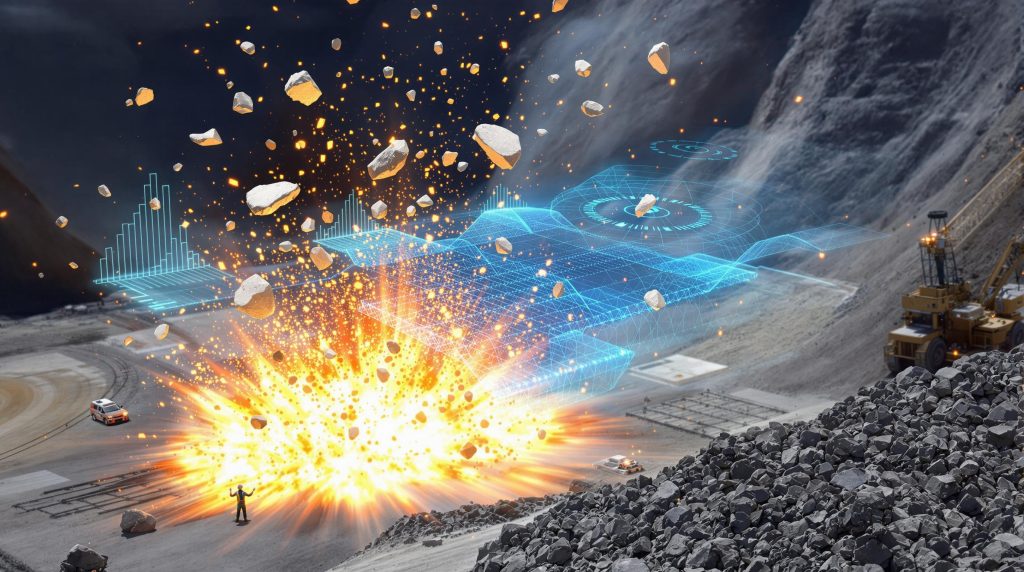Advanced Blasting Techniques and Simulation in Mining: Optimizing Efficiency and Safety
Mining operations have undergone remarkable transformation in recent decades, with blasting technology at the forefront of this evolution. Today's advanced blasting techniques combine precision engineering with sophisticated computational modeling to maximize resource recovery while minimizing operational risks and environmental impacts.
Evolution of Blasting Technology in Mining Operations
The mining industry has witnessed a significant shift from conventional blasting methods to precision-controlled approaches. Traditional blasting relied heavily on manual calculations and experience-based decisions, often resulting in inconsistent outcomes and inefficiencies.
Modern blasting techniques now leverage digital technologies to achieve unprecedented levels of control and predictability. The integration of geological mapping, 3D geological modelling, and electronic detonation systems has revolutionized how mining companies approach blast design and execution.
The transition to advanced techniques has yielded substantial improvements in fragmentation consistency, reduced ore dilution, and minimized unwanted environmental impacts such as ground vibration and airblast.
Core Components of Advanced Blasting Systems
Electronic detonation systems represent one of the most significant advancements in modern blasting. Unlike traditional pyrotechnic detonators with inherent timing variations, electronic systems can deliver millisecond-precise detonation sequences, allowing for complex blast patterns that control rock movement and fragmentation with unprecedented accuracy.
Smart explosive formulations have evolved to address varying geological conditions. These customized explosives can be adjusted for density, energy content, and sensitivity to optimize performance in specific rock types, moisture conditions, and temperature ranges.
Blast pattern optimization technologies analyze rock characteristics, structural geology, and desired outcomes to determine ideal hole placement, burden and spacing measurements, and charging parameters. This systematic approach replaces the traditional "rule of thumb" methods with evidence-based design.
How Do 3D Blast Simulations Transform Mining Operations?
Advanced 3D blast simulation software represents a quantum leap in mining technology, enabling engineers to predict and optimize blast outcomes before drilling the first hole.
Fundamentals of 3D Blast Simulation Technology
Modern blast simulation relies on sophisticated computational models that incorporate detailed geological data, explosive characteristics, and physics-based algorithms to predict rock behavior during detonation. These simulations account for complex variables including rock strength, jointing patterns, and stress fields.
The integration of high-resolution geological models allows blast engineers to visualize and account for variations in rock properties that would be impossible to manage with traditional planning methods. This data-rich approach enables precise tailoring of blast designs to specific geological conditions.
Real-time modeling capabilities allow engineers to rapidly test multiple scenarios, evaluating different drill patterns, explosive types, and timing sequences to identify optimal solutions. This virtual experimentation dramatically reduces the need for costly and time-consuming field trials.
When comparing traditional approaches with simulation-based methods, the differences are stark. Conventional techniques often relied on iterative field adjustments and learning through trial and error, while simulation-based approaches utilize predictive analysis to optimize designs before implementation.
Predictive Capabilities of Advanced Simulation Tools
One of the most valuable aspects of blast simulation is the ability to predict fragmentation outcomes. By analyzing how explosive energy will interact with specific rock structures, engineers can adjust designs to achieve the desired rock size distribution for downstream processing requirements.
Advanced simulation tools also forecast vibration patterns and environmental impacts with remarkable accuracy. This capability is particularly valuable when blasting near sensitive infrastructure, communities, or environmentally protected areas.
Muckpile shape and movement prediction systems allow operations to anticipate how blasted material will settle, enabling more efficient dig patterns for excavation equipment and reducing costly rehandling of material.
Ore dilution—the unwanted mixing of waste rock with valuable ore—can be minimized through simulation by predicting and controlling the movement of material boundaries during blasting. This preservation of ore grade directly impacts processing costs and recovery rates.
What Are the Economic Benefits of Precision Blasting?
The financial advantages of implementing advanced blasting techniques and simulation in mining extend throughout the mining value chain, from drilling to processing and beyond.
Operational Cost Reduction Through Simulation-Guided Blasting
Properly designed blasts significantly reduce the need for secondary breaking—the costly and time-consuming process of dealing with oversized rocks after blasting. Studies indicate that secondary breaking can add 15-30% to the total rock excavation costs when blasting is suboptimal.
Optimized explosive consumption represents another significant cost advantage. Simulation tools help engineers determine the precise amount and distribution of explosives needed for each blast, eliminating wasteful overcharging while ensuring adequate energy for proper fragmentation.
Equipment wear and maintenance requirements decrease substantially with well-designed blasts. Excavation equipment experiences less tooth and bucket wear when handling properly fragmented material, while crushers operate more efficiently and experience fewer jams and breakdowns.
Production Efficiency Improvements
Enhanced throughput rates represent one of the most immediate benefits of optimized fragmentation. When material size is consistent and appropriate for loading and crushing equipment, cycle times improve throughout the operation.
Reduced downtime from more predictable blast outcomes translates directly to increased production. When operators can confidently predict muckpile characteristics, they can plan equipment deployment more efficiently and minimize idle time.
Energy consumption in crushing and grinding circuits—often the most power-hungry processes in mining operations—can be reduced by 10-30% when feed material is properly fragmented. This translates to significant cost savings and reduced carbon footprint.
How Can Mines Minimize Blast Spillage and Protect Infrastructure?
Protecting critical infrastructure while maintaining production efficiency requires specialized blasting approaches, particularly in open-pit operations where access ramps represent vital lifelines.
Ramp Protection Strategies in Open-Pit Mining
Design considerations for blasts adjacent to critical infrastructure include modified burden dimensions, reduced charge weights, and specialized timing sequences that direct energy away from sensitive areas.
Controlled blast techniques utilizing deck charging, buffer blasting, and pre-splitting can dramatically reduce spillage onto access ramps. These approaches create clean, stable blast boundaries that minimize cleanup requirements.
Buffer zones—areas of unblasted rock between the main blast and critical infrastructure—serve as protective barriers against unwanted rock movement. Effective management of these zones requires careful planning and execution to balance protection with production goals.
The Tasiast gold mine in Mauritania, located 300km northeast of Nouakchott and operated by Kinross Gold Corporation since 2010, provides a notable example of AI in drilling and blasting. The operation implemented OREPro 3D Predict simulation software to model and minimize blast spillage onto crucial access ramps, significantly reducing cleanup requirements and maintaining operational continuity.
Advanced Techniques for Controlling Blast Movement
Vector analysis enables blast engineers to predict and control rock movement by modeling how explosive energy will propagate through specific geological formations. This approach helps determine optimal firing directions and sequences to manage material displacement.
Timing sequences represent powerful tools for directing blast energy and controlling rock movement. By adjusting millisecond delays between detonations, engineers can create preferential movement patterns that keep material where it's wanted.
Burden and spacing optimization—the distances between blast holes and free faces—plays a critical role in controlling displacement. Simulations help determine these parameters based on specific rock properties and desired outcomes rather than standard formulas.
Specialized stemming materials—the inert material placed above explosives in blast holes—significantly influence energy containment and utilization. Advanced operations select stemming types and configurations based on scientific analysis rather than convention.
What Role Does Data Analytics Play in Modern Blasting Operations?
The integration of data analytics with blasting operations creates powerful feedback loops that drive continuous improvement in blast design and execution.
Integration of Real-Time Monitoring with Blast Design
Seismic monitoring systems capture ground vibration data during blasts, providing valuable insights into explosive energy propagation and rock response. This information helps validate and refine simulation models while ensuring regulatory compliance.
Drone and LiDAR technology have revolutionized pre- and post-blast analysis by providing high-resolution 3D mapping capabilities. These tools enable precise measurement of blast movement, fragmentation outcomes, and conformance to design parameters.
Machine learning applications now identify patterns in blast outcomes that might escape human observation. By analyzing thousands of variables across multiple blasts, these systems can suggest optimization strategies that progressively improve results.
Creating feedback loops between monitoring and design systems enables data-driven mining operations to build institutional knowledge and continuously refine their blasting practices based on actual outcomes rather than theory alone.
Digital Twins and Virtual Blast Planning
Creating comprehensive digital representations of blast zones—often called "digital twins"—allows engineers to conduct virtual experiments in environments that precisely match real-world conditions. These models incorporate geological structures, existing excavations, and infrastructure elements.
Iterative simulation testing enables engineers to explore dozens or even hundreds of design variations before implementation, identifying optimal solutions without the cost and risk of field trials. This approach accelerates the learning curve for complex operations.
Integration with modern mine planning and ESG software ensures that blast designs align with long-term extraction strategies and grade control requirements. This holistic approach prevents optimization in one area from creating problems elsewhere in the operation.
How Are Environmental Impacts Mitigated Through Advanced Blasting?
Environmental considerations have become increasingly central to mining operations, with blasting practices evolving to minimize unwanted impacts while maintaining production efficiency.
Vibration and Airblast Control Methodologies
Techniques for predicting and minimizing ground vibration include wave form analysis, scaled distance calculations, and sophisticated timing designs that prevent vibration waves from different holes from reinforcing each other.
Airblast reduction strategies focus on proper stemming practices, controlled burden movement, and timing sequences that limit the simultaneous release of explosive gases. These approaches help operations maintain good community relations and regulatory compliance.
Compliance monitoring systems provide real-time data on vibration and airblast levels at sensitive locations, creating transparent documentation of environmental performance while enabling immediate adjustments if necessary.
Dust and Fume Management in Modern Blasting
Advanced stemming materials designed specifically for fume reduction help contain explosive gases and promote complete detonation, significantly reducing harmful nitrogen oxide emissions compared to traditional stemming practices.
Water-resistant explosives maintain performance in wet conditions without requiring plastic liners or other environmentally problematic containment systems. These formulations reduce both water pollution risks and plastic waste generation.
Dust suppression techniques integrated with blast design include mist systems, binding agents, and timing sequences that limit dust generation and dispersion. These approaches protect both the environment and worker health.
What Safety Improvements Come with Advanced Blasting Technologies?
Safety enhancement represents perhaps the most compelling benefit of advanced blasting technologies, with multiple systems working together to reduce risks throughout the blasting process.
Enhanced Safety Through Precision and Predictability
Reduction in flyrock incidents—one of the most dangerous blast-related hazards—comes from accurate prediction of rock movement through simulation and implementation of appropriate design adjustments. Electronic detonation systems further reduce risk by enabling precise control of energy distribution.
Remote detonation systems allow personnel to initiate blasts from safe locations with reliable communication systems and built-in safety checks. These systems eliminate the need for personnel to remain near loaded blast patterns and provide verification of detonator functionality before firing.
Misfire prevention through electronic detonation technology represents a significant safety advancement. Unlike traditional systems, electronic detonators provide pre-blast verification of functionality and maintain their timing precision regardless of external conditions.
Training and competency development for advanced blasting operations have evolved to incorporate simulation-based learning environments where personnel can practice complex scenarios without risk. This approach accelerates skill development while reinforcing safety protocols.
Risk Assessment and Management in Modern Blasting
Comprehensive risk analysis methodologies for complex blasts now incorporate quantitative elements rather than relying solely on subjective assessments. These approaches systematically identify potential failure modes and implement appropriate controls.
Integration of weather and environmental factors into safety planning includes sophisticated monitoring of lightning risk, wind conditions, and atmospheric inversions that might concentrate fumes or affect blast performance.
Exclusion zone optimization through advanced modeling helps operations determine appropriate clearance distances based on specific blast parameters rather than generic guidelines. This science-based approach enhances safety while avoiding unnecessarily conservative restrictions.
How Are Fragmentation Outcomes Optimized for Downstream Processing?
The connection between blasting and processing efficiency has become increasingly clear, with leading operations now designing blasts specifically to optimize downstream performance.
Tailoring Fragmentation to Processing Requirements
Matching blast fragmentation to crusher and mill specifications requires detailed understanding of equipment capabilities and limitations. Advanced operations develop fragmentation targets based on comprehensive analysis of the entire comminution circuit rather than focusing on blasting in isolation.
Grade control integration with blast design helps prevent unwanted dilution or ore loss during the blasting process. By accounting for geological boundaries and ore distribution in blast design, operations can maintain grade integrity from the mine face through processing.
Selective blasting techniques for complex orebodies enable differential fragmentation of ore and waste within the same blast pattern. This approach facilitates easier separation during excavation and can significantly improve resource recovery.
The economic impact of optimized fragmentation extends far beyond blasting costs. Studies indicate that each dollar saved in comminution energy through proper fragmentation can represent $5-10 in total operational savings when considering throughput improvements, equipment life extension, and recovery enhancement.
Measurement and Analysis of Fragmentation Results
Advanced image analysis systems for fragmentation assessment use truck-mounted cameras, drone photography, and artificial intelligence to provide objective, consistent measurement of blast outcomes. These systems eliminate the subjectivity of visual assessment and enable data-driven optimization.
Real-time feedback mechanisms allow operations to quickly identify when blast outcomes deviate from expectations and implement corrective measures. This rapid response capability prevents suboptimal fragmentation from impacting downstream processes for extended periods.
Correlation between predicted and actual fragmentation outcomes provides valuable validation of simulation models and helps refine future designs. Leading operations maintain comprehensive databases of blast designs and outcomes to build institutional knowledge and drive continuous improvement.
What Future Innovations Are Emerging in Mining Blast Technology?
The pace of innovation in blasting technology continues to accelerate, with several promising developments poised to further transform mining operations.
Autonomous Blast Design and Implementation
AI-driven blast pattern optimization systems capable of generating designs based on specific geological conditions and operational objectives are beginning to emerge. These systems incorporate machine learning to progressively improve outcomes based on operational feedback.
Automated drilling accuracy, enabled by GPS-guided drill rigs and real-time deviation measurement, significantly improves the implementation of blast designs. When holes are placed precisely as designed, the reliability of simulation predictions increases dramatically.
Self-adjusting blast designs based on real-time geological data represent the next frontier in precision blasting. Systems that can modify charging parameters based on information gathered during the drilling process are already being tested at several operations.
Integration with autonomous mining equipment ecosystems ensures that blast outcomes align with the capabilities of robotic excavation and haulage systems. This holistic approach to automation optimizes the entire mining cycle rather than individual components.
Sustainable Blasting Technologies on the Horizon
Lower-energy explosive formulations that maintain performance while reducing environmental impact are under active development. These include emulsions with optimized energy distribution and systems that incorporate renewable or recycled components.
Reduced environmental footprint through precision techniques includes technologies that minimize overbreak, control vibration, and limit dust and fume generation. These approaches help operations maintain their social license to operate in environmentally sensitive areas.
Integration with renewable energy systems for blast operations includes solar-powered monitoring equipment, electric stemming vehicles, and low-carbon explosive manufacturing processes. These technologies align with broader mining innovation trends to reduce carbon emissions.
Circular economy approaches to explosive manufacturing and use focus on recycling components, repurposing waste materials as ingredients, and designing for minimum environmental persistence. These initiatives reduce both costs and environmental impacts while improving sustainability metrics.
FAQ: Advanced Blasting Techniques and Simulation
What is the primary advantage of 3D blast simulation compared to traditional methods?
The most significant advantage of 3D blast simulation lies in its predictive capabilities that eliminate the trial-and-error approach of traditional methods. While conventional techniques rely on post-blast analysis to make incremental improvements, simulation allows engineers to visualize and optimize outcomes before implementation.
The cost and safety benefits of virtual testing are substantial, eliminating the risks associated with experimental field blasts while reducing the number of suboptimal blasts that require rework or create downstream processing issues.
How do electronic detonators improve blasting outcomes compared to non-electric systems?
Electronic detonation systems provide millisecond-precise timing control regardless of environmental conditions, enabling complex blast sequences that would be impossible with traditional systems. This precision directly impacts fragmentation consistency, vibration control, and overall blast efficiency.
Reliability improvements from electronic systems dramatically reduce misfire rates compared to non-electric alternatives. Modern electronic systems feature built-in testing capabilities that verify functionality before blasting, virtually eliminating the dangerous and costly problem of unexploded charges.
The integration capabilities with monitoring and simulation systems create powerful synergies that drive continuous improvement. Electronic systems can implement precisely the timing sequences determined by simulation software while providing detailed data for post-blast analysis.
What training is required for mining personnel to effectively utilize advanced blast simulation tools?
Essential competencies for blast engineers now extend beyond traditional explosive knowledge to include computer modeling, data analysis, and an understanding of rock mechanics. This multidisciplinary skill set enables the full utilization of simulation capabilities.
Training pathways typically include formal education in mining engineering or geotechnical fields, supplemented by specialized software training provided by technology vendors. Many leading mining companies have established dedicated blasting centers of excellence to develop these specialized skills internally.
Ongoing professional development remains critical as technology evolves rapidly. Engineers must continuously update their skills through industry conferences, specialized courses, and participation in user communities focused on blasting technology.
How can mines measure the ROI of implementing advanced blasting technologies?
Key performance indicators for blast optimization include fragmentation metrics, dig rates, crusher throughput, energy consumption, and secondary breaking requirements. Comprehensive measurement across these areas provides a holistic view of the true value created.
Methodologies for calculating direct
Want to Capitalize on the Next Major Mineral Discovery?
Stay ahead of the market with Discovery Alert's proprietary Discovery IQ model, which instantly notifies investors of significant ASX mineral discoveries and transforms complex data into actionable insights. Visit the Discovery Alert discoveries page to understand why historic discoveries can generate substantial returns, and begin your 30-day free trial today.




